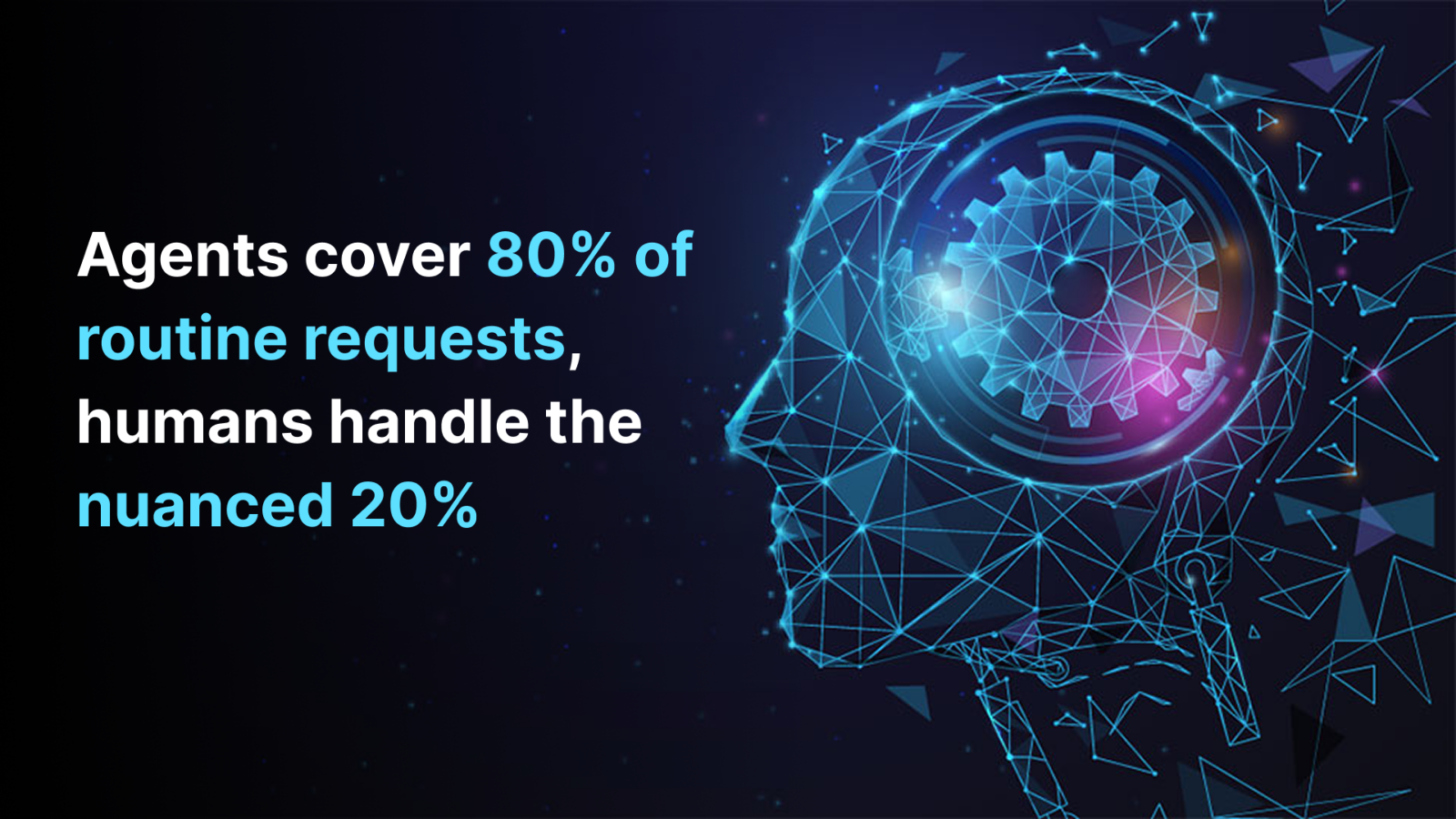AI Agents: Where They Really Help Businesses and How to Deploy Them Safely in 2025

What are AI agents and why do businesses need them?
An AI agent is an autonomous software system that can perceive its environment, make decisions, and act toward achieving a specific goal. Unlike traditional AI assistants or chatbots that only respond to prompts, agents can take initiative: they plan multi-step actions, use external tools via APIs, and adapt their behavior as conditions change. In short, they act less like calculators and more like digital colleagues.
According to Gartner, by 2028 nearly one-third of enterprise applications will include agentic AI features. This shift is happening because businesses face increasing pressure to handle large volumes of data, deliver 24/7 customer interactions, and shorten product development cycles. AI agents help by taking over routine but critical tasks (monitoring dashboards, generating reports, or handling customer requests) so employees can focus on strategy and innovation.
Autonomy brings efficiency but also new responsibilities. A more independent agent reduces manual work, yet it demands stronger governance: audit logs, guardrails, and human oversight to ensure decisions remain transparent and aligned with business goals.
Where do AI agents deliver measurable results?
AI agents create the most value in areas where processes are repetitive, data-driven, and require quick responses. Instead of replacing entire teams, they extend capacity, cut operational costs, and free people from low-value work. Companies that adopt them strategically often see measurable ROI within months.
Customer support: reducing workload on human agents
Customer support is one of the most visible use cases for AI agents. Unlike static chatbots, agents can understand intent, access internal systems, and resolve requests end-to-end. For example, insurance company Lemonade reports that nearly 40% of claims are processed without human intervention.
The benefits are clear: 24/7 availability, faster response times, and significant reduction in backlog. A single AI agent can handle thousands of routine tickets like password resets, order status checks, and refund requests without escalating to a live agent. This allows support teams to focus on complex cases where empathy and judgment matter.
Yet efficiency comes with risks. While agents excel at structured, repetitive tasks, they can fail in edge cases that require contextual reasoning. Over-reliance on automation without proper escalation paths may frustrate customers instead of delighting them.

Marketing and sales: automation and personalization
AI agents are particularly effective in lead management and campaign optimization. They can qualify leads, score them based on historical data, trigger personalized follow-ups, and even adjust ad spend dynamically. In B2B sales, agents can track competitor pricing and recommend counter-strategies in real time.
For marketing teams, this means fewer hours spent on manual segmentation and more time for creative work. Companies using AI-driven lead nurturing often see conversion rates increase by 20–30% within a quarter.
Personalization at scale depends on the quality of CRM and marketing data. If data is incomplete or inconsistent, agents can make inaccurate recommendations, leading to wasted spend or irrelevant outreach. Human review is essential to keep automation aligned with brand voice and strategy.
R&D and product: accelerating research cycles
In research-intensive industries, AI agents can digest vast amounts of information from academic publications to patent databases and surface relevant insights in hours rather than months. Merck, for instance, reduced compound analysis timelines from six months to just six hours using agent-driven systems.
For product managers, agents can run customer feedback analysis, detect unmet needs, and suggest feature prioritization. This allows teams to validate hypotheses faster and reduce time-to-market.
While agents accelerate discovery, they cannot fully replace subject-matter expertise. Speed without validation risks chasing false leads or overlooking critical details. The optimal model is agents for exploration, humans for confirmation.
Finance and compliance: monitoring and reporting
Finance teams benefit from agents that can reconcile transactions, flag anomalies, and generate compliance reports automatically. In regulatory-heavy sectors like banking or healthcare, agents can track rule changes and notify teams of potential gaps in compliance.
This reduces the manual burden of routine checks and ensures organizations stay audit-ready. Some companies report up to 40% reduction in compliance monitoring costs after deploying AI-driven agents.
Reliance on automated monitoring requires constant updates to data sources and regulatory logic. If the rules engine falls behind, companies risk non-compliance penalties. Agents lower operational costs, but governance frameworks must remain strong.
Software engineering and IT: supporting developers
For developers, AI agents act as tireless assistants. They review code, generate unit tests, suggest bug fixes, and even automate deployments through CI/CD pipelines. GPT-Engineer or Amplication show how code generation can speed up delivery by 30–50%.
Beyond coding, agents can monitor infrastructure logs, detect anomalies, and trigger remediation workflows. This shortens incident response times and reduces downtime.
It’s important to remember that automated code review and generation improve speed but can miss subtle architectural or security issues. Over-trusting agents in production systems may lead to technical debt or vulnerabilities. The best practice is a “dual layer”: agents for routine checks, senior engineers for critical decisions.
How do companies decide where to use AI agents first?
Not every process is a good fit for autonomous agents. The best results come from targeting areas that are structured, repetitive, and measurable. Before deploying agents, companies should map their workflows and identify tasks with clear ROI. Examples include ticket triage, invoice processing, or log monitoring – processes with predictable inputs and well-defined outputs.
Analysts at Gartner emphasize that agentic capability exists on a spectrum. Early adoption should focus on “low-hanging fruit”: processes where the cost of errors is low and the value of automation is high. Once trust is built and governance mechanisms are in place, organizations can move to more complex, cross-department scenarios.
Сhoosing simple use cases first ensures fast wins but may delay the impact of AI on strategic, high-value areas. On the other hand, jumping too quickly into mission-critical processes can backfire if the technology is not mature enough. The most successful companies balance both: starting small but with a roadmap that gradually extends agent capabilities to core operations.
Step-by-step deployment guide
Rolling out AI agents should be treated as a structured program, not a quick plug-in. A staged approach allows companies to minimize risk while capturing early benefits.
Step 1. Process audit and pilot selection
Start by mapping out business processes and identifying tasks that are repetitive, rule-based, and measurable. Good candidates include ticket triage, status updates, and financial reconciliations. Select one or two pilot use cases with clear ROI potential and limited downside if errors occur.
Focusing only on “safe” pilots speeds up adoption but may limit strategic impact in the short term.
Step 2. Technical integration (APIs, monitoring, logging)
Agents are only as powerful as the systems they can connect to. Make sure APIs are available for key platforms (CRM, ERP, ticketing systems) and that data flows securely between them. Implement monitoring and logging so every action can be audited. This is critical for compliance and trust.
Deeper integrations unlock more automation but require higher upfront engineering effort.
Step 3. Human-in-the-loop for quality assurance
Keep humans in control during the early phases. Let agents execute tasks, but require human review or approval for final decisions. This builds confidence, surfaces edge cases, and allows teams to fine-tune prompts and guardrails before scaling autonomy.
Step 4. Scaling after initial success
Once pilot KPIs are achieved (such as reduced ticket backlog or faster report generation), expand agents into cross-department workflows. This is where they deliver exponential value, passing tasks from one agent to another across customer support, marketing, finance, and IT.

Fast ROI is achievable, but only if companies invest in governance, security, and integration infrastructure from the start.
What are the key risks and limitations?
AI agents offer real efficiency gains, but they also introduce new challenges that businesses must anticipate. Ignoring these risks can quickly erode trust and offset any productivity benefits.
- Hallucinations and factual errors. Agents powered by large language models may generate incorrect or misleading outputs. Without validation layers, this can propagate errors into critical workflows.
- Transparency and trust in autonomous decision-making. When agents act without human review, stakeholders may question how decisions are made. Clear audit trails and explainability are essential to maintain trust.
- Integration challenges with legacy systems. Many enterprise environments still rely on older platforms with limited API access. Connecting agents to these systems often requires custom engineering, which can slow adoption.
- Security risks, including malicious use of agentic capabilities. Just as agents can automate beneficial tasks, attackers could exploit them for harmful purposes. Governance, access controls, and anomaly detection are mandatory safeguards.
Autonomy accelerates operations but demands stronger oversight. Companies must strike a balance: deploying agents where efficiency gains outweigh risks, while building guardrails that protect against errors, misuse, or system failures.
Frequently Asked Questions (FAQ)
An AI agent in 2025 is an autonomous software system that can perceive inputs, plan actions, and execute tasks toward a defined goal. Unlike traditional AI tools, agents can operate independently, interact with APIs, and adapt to changes in real time.
Chatbots answer user queries in a conversational format but rely on predefined prompts. AI agents go further: they can make decisions, trigger workflows, and complete tasks end-to-end. In short, a chatbot responds, while an agent acts.
No. AI agents can handle up to 70–80% of routine customer queries, such as refunds or password resets, but complex cases still require human empathy and judgment. The best model is hybrid: agents process simple issues, humans manage escalations.
Processes that are repetitive, data-driven, and well-structured. Examples include support ticket triage, invoice reconciliation, compliance reporting, and lead scoring. These areas show fast ROI because tasks have predictable inputs and outputs that agents can manage reliably.
Key risks include hallucinations, lack of transparency in decision-making, integration difficulties with legacy systems, and security vulnerabilities. Without guardrails, agents may amplify errors or be exploited maliciously. Strong monitoring and governance are essential safeguards.
Budgets vary widely. A pilot project can start at $50k–$150k, covering integration, monitoring, and training. Scaling across departments can cost several times more, depending on infrastructure readiness and compliance requirements. ROI often offsets investment within the first year.
High-volume, data-intensive industries benefit first: financial services, insurance, retail, SaaS, and healthcare. These sectors have repetitive workflows, strict reporting needs, and significant customer interaction, which are ideal conditions for automation. R&D-heavy industries like pharmaceuticals also see measurable gains.
Yes, for simple and repetitive tasks. However, critical processes still require human-in-the-loop review for accuracy, compliance, and trust. Fully unsupervised agents are rare in 2025, but semi-autonomous models are increasingly common in customer service and IT operations.
Integration typically requires API access, workflow orchestration, and monitoring tools. Agents connect to CRMs, ERPs, or ticketing systems to act on data. For legacy platforms, custom connectors or middleware may be needed. Logging and audit trails are essential for compliance.
By 2030, AI agents are expected to move from single-task automation to multi-agent collaboration, where different agents coordinate across departments. Gartner predicts that a significant share of routine business decisions will be delegated to agents, shifting employees toward oversight, strategy, and innovation.